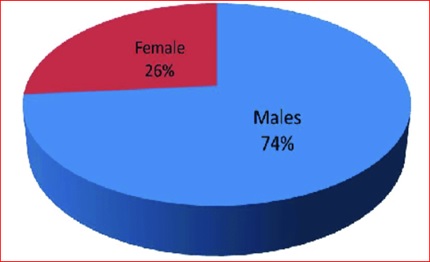Prevalence of hyperuricemia in cerebrovascular accidents and its correlation with their outcome
Abstract
Introduction: Cerebrovascular accident or stroke is a disease of the vascular system of the brain. According to ICD 11, stroke is classified as a neurological disease and not under the circulatory system. It is the second leading cause of death worldwide. It cannot be said that high Serum Uric Acid [SUA] amongst patients with cerebrovascular accidents is directly correlated with their outcome. The present study planned to estimate uric acid levels and their association in acute stroke patients, both ischemic and hemorrhagic.
Method: A total of 100 stroke patients admitted under the neurology department were included in the study. Brain imaging (CT/MRI) was performed. The serum uric acid was estimated.
Results: Out of a total of 100 patients, 74 were males, and 26 were females. Nine patients were less than 45 years old and 91 patients were 45 and above. Thirty-nine patients had ischemic, and 61 patients had a hemorrhagic stroke, respectively. Out of 100 patients, 23 patients had normal uric acid levels (<7mg/dl). Seventy-seven patients were with high uric acid levels. The mean serum uric acid concentration in male patients was 8.48±2.7and 9.20±2.7 in females. Among the total 100 cases, 69 survived, and the remaining 31 were among the non-survivor group at the time of discharge. Mean serum uric acid in stroke survivors was 8.5±2.6 mg/dl, while in non-survivors, it was 8.6±2.2 mg/dl. There was no significant difference between the levels of uric acid among survivors and non-survivors.
Conclusions: The prevalence of hyperuricemia (>9mg/dl) amongst stroke patients was 77% in the present study. The values of serum uric acid were significantly elevated in the patients aged > 45 years. The serum uric acid values were high among the group of hyperglycemic and hypertensive patients at the time of admission. There was no significant difference between the levels of uric acid among survivors and non-survivors.
Downloads
References
Wade S. Smith, S. Claiborne Johnston, J. Donald Easton. Cerebrovascular diseases. Harrison's Principles of Internal medicine, 16th Edition. Volume II: Mac Graw Hill, 2005; 2372-2380.
Banerjee, Tapas Kumar, and Shyamal Kumar Das. Epidemiology of Stroke in India. Neurology Asia 11 (2006): 1-4.
Jose Biller and Besty B.Love, Ischemic Cerebrovascular disease. Vascular diseases of the Nervous system. Walter G.Bradley Robert B.Daroff, Gerald. M,Fenichel, Joseph Jankovic. Neurology in clinical practice. 4th Edition, Volume II: Butterworth Heinemann, 2004; 1197-1200.
Adams HP Jr, Bendixen BH, Kappelle LJ, Biller J, Love BB, Gordon DL, et al. Classification of subtype of acute ischemic stroke. Definitions for use in a multicenter clinical trial. TOAST. Trial of Org 10172 in Acute Stroke Treatment. Stroke. 1993 Jan;24(1):35-41. doi: 10.1161/01.str.24.1.35.
Chung, C. S., Whaley, J., Kley, N., & Anderson, K. Louis. R. Caplan. Neurovascular disorders. Christopher G. Goetz. Textbook of clinical Neurology 2nd Edition: Saunders (2003):991-1014.
Christopher J. Weir, PhD; Scott W. Muir, MBChB, MRCP; Matthew R. Walters, MD, MRCP; Kennedy R. Lees, MD, FRCP- Predictor of Poor Outcome and Future Vascular Events After Acute Stroke. 2003;34:1951
Manolio TA, Kronmal RA, Burke GL, O'Leary DH, Price T.R. Short-term predictors of incident stroke in older adults. The Cardiovascular Health Study. Stroke. 1996 Sep;27(9):1479-86. doi: 10.1161/01.str.27.9.1479.
Bamford J, Sandercock P, Dennis M, Warlow C, Jones L, McPherson K, et al. A prospective study of acute cerebrovascular disease in the community: the Oxfordshire Community Stroke Project 1981-86. 1. Methodology, demography and incident cases of first-ever stroke. J Neurol Neurosurg Psychiatry. 1988 Nov;51(11):1373-80. doi: 10.1136/jnnp.51.11.1373.
Jørgensen HS, Plesner AM, Hübbe P, Larsen K. Marked increase of stroke incidence in men between 1972 and 1990 in Frederiksberg, Denmark. Stroke. 1992 Dec;23(12):1701-4. doi: 10.1161/01.str.23.12.1701.
Tell GS, Fried LP, Hermanson B, Manolio TA, Newman AB, Borhani NO. Recruitment of adults 65 years and older as participants in the Cardiovascular Health Study. Ann Epidemiol. 1993 Jul;3(4):358-66. doi: 10.1016/1047-2797(93)90062-9.
Chamorro A, Obach V, Cervera A, Revilla M, Deulofeu R, Aponte JH. Prognostic significance of uric acid serum concentration in patients with acute ischemic stroke. Stroke. 2002 Apr;33(4):1048-52. doi: 10.1161/hs0402.105927.
Verdecchia P, Schillaci G, Reboldi G, Santeusanio F, Porcellati C, Brunetti P. Relation between serum uric acid and risk of cardiovascular disease in essential hypertension. The PIUMA study. Hypertension. 2000 Dec;36(6):1072-8. doi: 10.1161/01.hyp.36.6.1072.
Loana Mozoa , Camelia Chiulana , CorIna Goruna , T.Costeaba Annals of West University of Timisoara Series of Chemistry 16 (2) (2007) 227 – 236.
Mehrpour M, Khuzan M, Najimi N, Motamed MR, Fereshtehnejad SM. Serum uric acid level in acute stroke patients. Med J Islam Repub Iran. 2012 May;26(2):66-72.
Rangavenamma, S., Goduguchintha Lepakshi, and Nagatham Padmaja. A Study of Serum Uric Acid Levels in Acute Ischemic Stroke Patients Admitted in Tertiary Care Hospital At Tirupati. stroke 5: 6.

Copyright (c) 2021 Author (s). Published by Siddharth Health Research and Social Welfare Society

This work is licensed under a Creative Commons Attribution 4.0 International License.


 OAI - Open Archives Initiative
OAI - Open Archives Initiative


